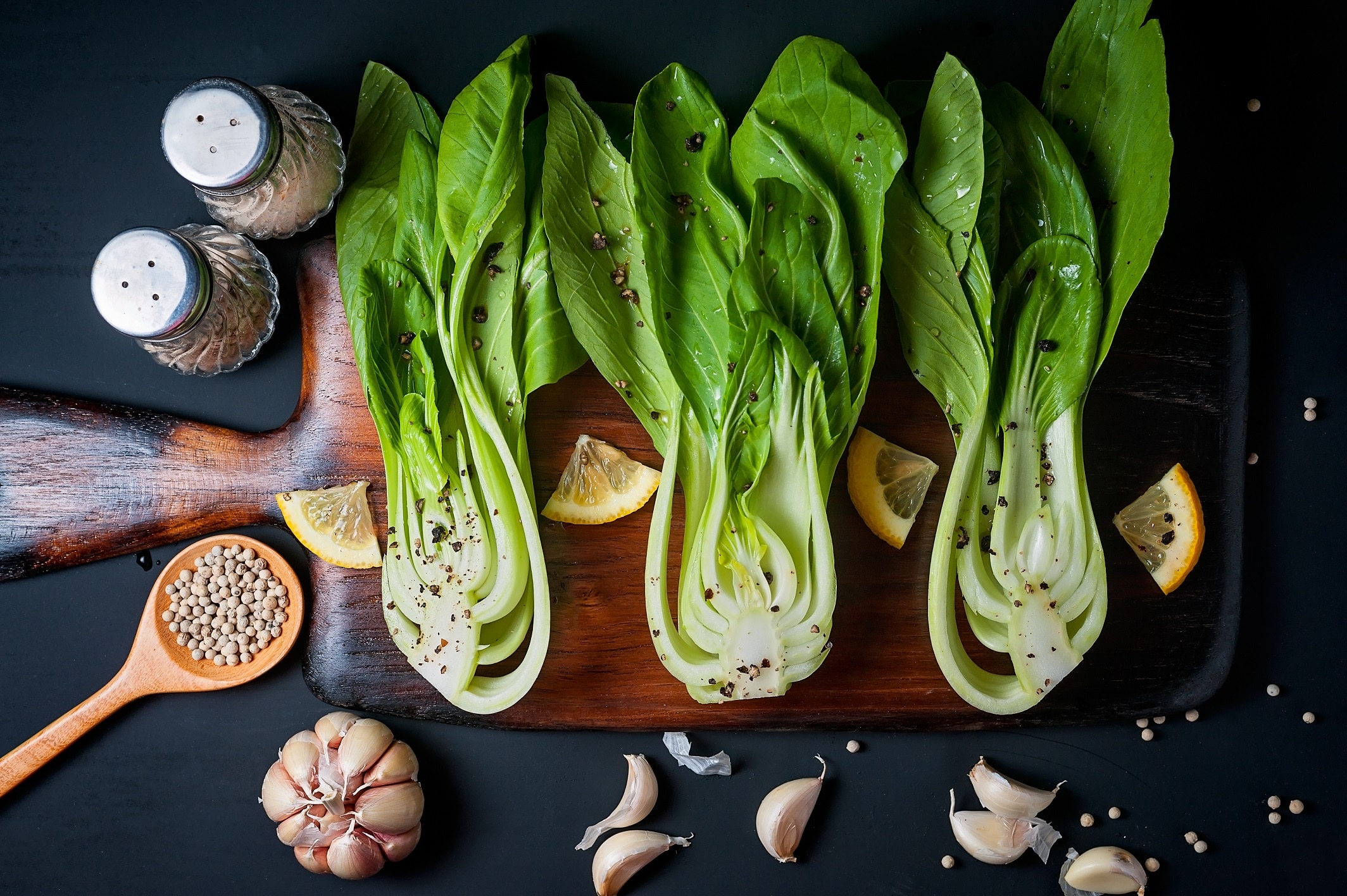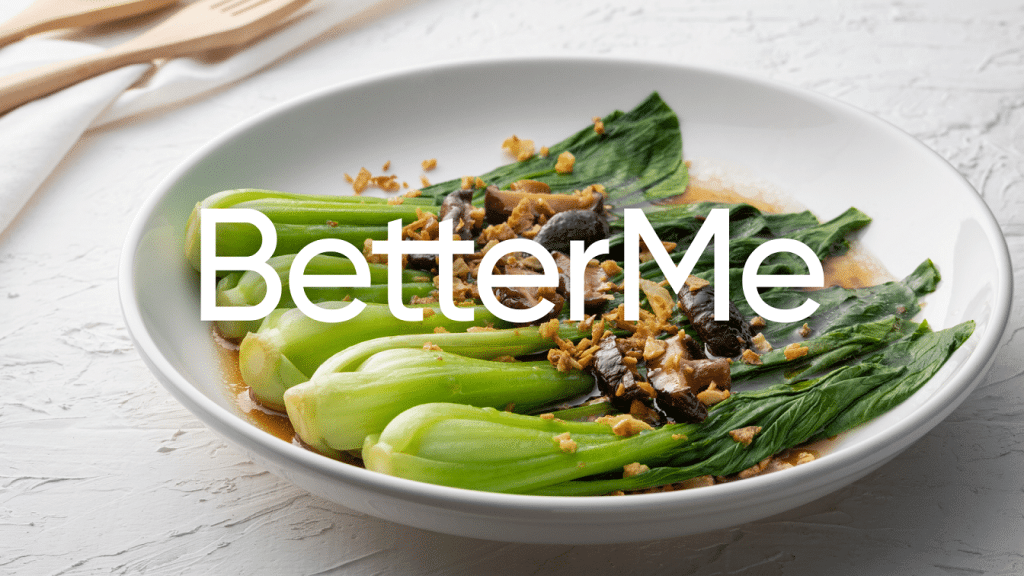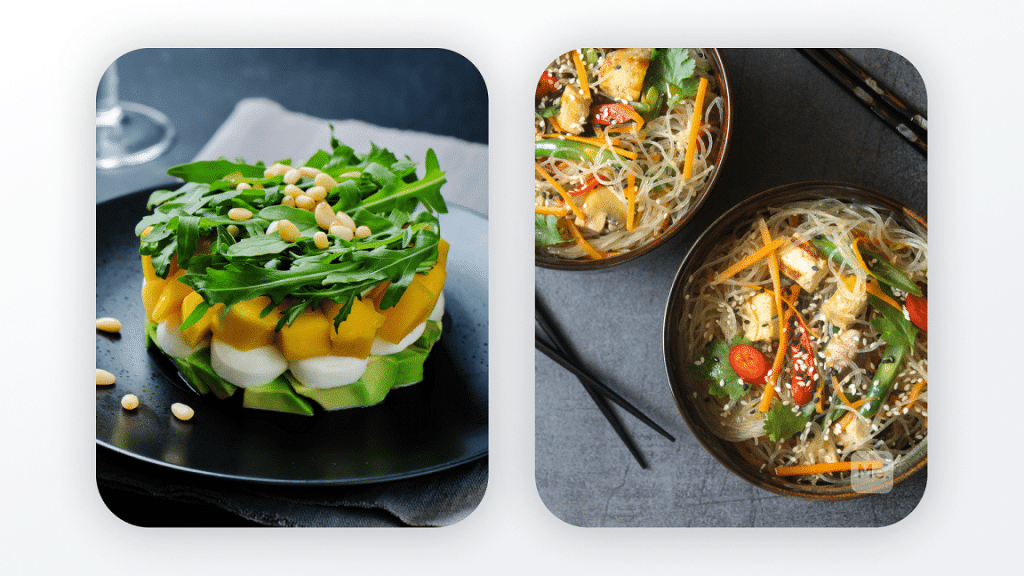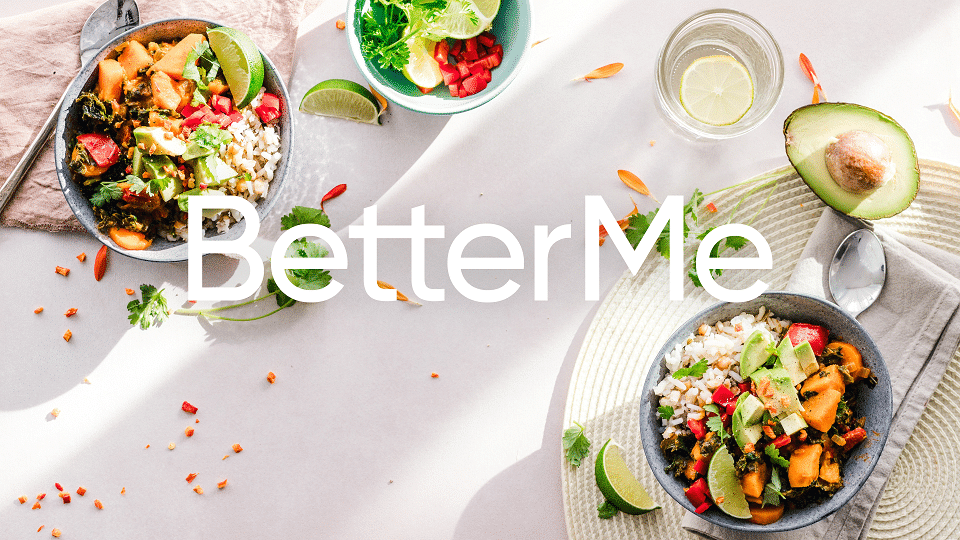Bok choy or pak choi is part of the cabbage family. It has large green leaves with thick white stems. It has a mild flavor and is often used in Chinese cooking. The plant can be prepared raw or cooked, and is commonly added to soups or stir-fried. Though it has many health benefits and only a few side effects, it’s not for everyone. This article will tell you everything you need to know about Bok Choy, including the various ways of eating it, its nutritional value, how to pick out good products at the market, what cooking techniques are recommended with Bok Choy, and more. You’ll also learn about some of the most popular recipes using this delicious green veggie!
Get your personalized
meal plan!
Bok Choy Nutrition Facts
One cup (70 grams) of shredded bok choy has the following nutritional profile (2):
- Calories: 9
- Protein: 1 gram
- Total fat: 0 grams
- Total carbs: 1.5 grams
- Total sugar: 1 gram
- Fiber: 1 gram
- Calcium: 6% of the Daily Value (DV)
- Iron: 3% of the DV
- Magnesium: 3% of the DV
- Phosphorus: 2% of the DV
- Potassium: 4% of the DV
- Zinc: 1% of the DV
- Manganese: 5% of the DV
- Selenium: 1% of the DV
- Vitamin C: 35% of the DV
- Folate: 12% of the DV
- Vitamin A: 17% of the DV
- Vitamin K: 27% of the DV
Bok Choy Health Benefits
Many of the health benefits that bok choy offers have to do with its micronutrient content. They include:
Anticancer Properties
Bok Choy, like other cruciferous vegetables, is rich in glucosinolates, which are plant compounds with potential anticancer and chemoprotective properties. Particularly, bok choy contains glucoraphanin which converts into sulforaphane in the body. The latter compound has been found to have possible protective effects against cancer including bladder cancer, breast cancer, colon cancer, lung cancer, and prostate cancer. Other names for sulforaphane include allyl-isothiocyanate (4).
Cardiovascular System Protection
The isothiocyanates found in bok choy are believed to have protective effects against diseases related to the cardiovascular system. For example, research on animals has shown that sulforaphane can help prevent atherosclerosis by reducing inflammatory processes, oxidative stress, and lipid deposition (14).
Antioxidant Capacity
Bok Choy is a great source of antioxidants as well as micronutrients that play an important role in the mitigation of oxidative stress, such as carotenoids, zinc and selenium. Oxidative stress is believed to be one of the key factors in aging (1).
Read More: Prunes Benefits, Nutrition Facts, Preparation Methods, And Side Effects
Anti-Inflammatory Properties
Bok choy is also rich in beneficial anti-inflammatory compounds such as ferulic acid and quercetin, which contribute to its potential health benefits for inflammatory diseases such as arthritis, asthma and atherosclerosis. Studies on animals have shown that these substances can act as anti-inflammatory agents (5).
Digestive Health
Bok choy is rich in fiber, which plays an important role in digestion. Fibers are believed to bind to toxins and take them out of the gastrointestinal tract. Moreover, they also help prevent constipation and maintain regular bowel movements (9). The American Dietetic Association recommends that adults consume 20-35 grams of fiber per day, most of it from fruits and vegetables (6).
May Support Bone Health
Bok choy also contains calcium, phosphorus, and other nutrients like vitamin K, which all contribute to bone health (10).
May Support Weight Loss
Bok Choy is a very low-calorie food. One cup of shredded bok choy has only 9 calories (2). Due to its high water content (93%) and low calorie content, it can be included in weight-loss diets.
Side Effects And Precautions
The following side effects may be caused by consuming large amounts of bok choy:
Allergy Symptoms
Although uncommon, bok choy is a source of food allergens for some people.This is due to the presence of proteins that can cause a reaction in those who are sensitive or allergic to them (17).Bok choy may also trigger allergic reactions in those who are allergic to other vegetables in the cruciferous family.
Impaired Thyroid Function
Cruciferous vegetables such as bok choy contain an enzyme called myrosinase, which is released when the raw vegetable is chewed or cut. Myrosinase breaks down glucosinolates, releasing some byproducts which may impair thyroid function (11).
Please note, cooking bok choy deactivates the enzyme myrosinase, so thyroid inhibition isn’t a concern with cooked bok choy (7).
Abdominal Cramps And Bloating
Cruciferous vegetables such as bok choy contain high levels of fiber, which tends to cause increased gas production in the stomach. Consumption of these vegetables in large amounts can result in cramps and bloating, especially if you are not used to a high fiber diet (16). When increasing your fiber intake, it is best to do so gradually and to also increase your fluid intake at the same time.
Interaction With Blood Thinning Medications
Bok choy contains vitamin K, which is a nutrient that plays an important role in blood clotting. Consuming bok choy with medications that reduce the effects of vitamin K (such as blood thinning drugs) can increase one’s risk of bleeding (15). Keeping vitamin K intake consistent is key when on blood thinning medications, so work with your doctor and dietitian to help you navigate that balance.
If you’ve mustered up the courage to crush your weight loss goal, let Betterme take the sting out of this demanding process. Our app will help you restructure your habits, remold your life and crank up your fitness results!
Bok Choy Cooking
When cooking with bok choy, remember that the white stalks are more tender than dark green leaves. Here are some popular cooking techniques:
Stir-Frying Bok Choy
Stir-frying is probably the most popular cooking technique for bok choy. It only takes about 3 minutes to cook. To stir fry bok choy, cut the stalks into pieces of desired size and length, keeping the leaves intact. Heat up oil in a wok or frying pan over high heat and add bok choy. Stir-fry for a few minutes until tender and cooked through, then season with salt or soy sauce.
Steaming Bok Choy
To steam bok choy, use the same chopping technique as for stir-frying and place in a steamer basket over boiling water for about 3 minutes.
Boiling Bok Choy
To boil bok choy, first, chop into pieces and then blanch for a few minutes in boiling water. Drain and season with salt or soy sauce.
Use In Soups
You can make your soups more fibrous and nutritious by adding bok choy. Just add chopped bok choy during the last few minutes of cooking and it will retain both its flavor and texture.
Add To Sushi Rice Or Noodles
Bok choy is an excellent way to make your sushi rice look more appealing. Chop up some bok choy and mix with sushi rice. You can also add bok choy to noodles made from buckwheat or soba, which will increase their nutritional value and make them taste better as well.
Saute With Oil And Fresh Spices
Sauteing with oil and spices is a great way to add flavor to bok choy without making it soggy. Chop up some bok choy and saute in oil or ghee with garlic, red chili flakes, or fresh herbs. Serve on its own or over rice for a quick meal.
Shredded In A Salad
Uncooked bok choy can also be used in salads or eaten with dips, such as hummus. Just chop up the stalks into pieces of desired length and thickness, keeping leaves intact. Add to your salad for extra crunchiness, or serve with your favorite dipping sauce.
Oven Roasted For Extra Crunch
To make roasted bok choy, chop the stalks into pieces of desired thickness and place on a baking sheet. Sprinkle it with salt and drizzle olive oil over top. Roast in a 450° oven for about 10 minutes or until tender and slightly browned. These make a tasty weight loss snack.
In A Sandwich
Bok choy goes well in sandwiches, in place of lettuce or any other vegetable. It can also be sauteed and mixed with egg for breakfast.
Read More: Watercress Benefits, Nutrition Facts, Side Effects, And More
How To Buy And Store The Freshest Bok Choy
Bok choy is available year-round but with peak season during the spring and fall months. Before buying bok choy, look for firm stalks without wrinkles or dark spots along with crispy leaves.
Store fresh bok choy in your refrigerator’s crisper drawer. It should remain fresh for about one week if properly wrapped.
Bok Choy Recipes To Try At Home
Here are some simple and amazing bok choy recipes you can whip up at home:
Chinese Stir-Fried Baby Bok Choy (3)
This recipe delivers a sweeter flavor compared to those using the adult variant. For a lighter taste, we recommend you use olive oil and low sodium chicken broth in place of water. Here’s how you make it:
Ingredients:
- 4 bunches baby bok choy, 1 bunch per person
- 1 ½ tablespoons vegetable oil, for stir frying
- 2 slices ginger
- 2 tablespoons soy sauce
- 1 teaspoon sugar, or to taste
- ¼ teaspoon salt, or to taste
- ¼ cup water
- Few drops sesame oil
Instructions:
- Wash and drain the baby bo choy then halve it lengthwise, followed by cutting it across into small pieces. Separate the leaves from the stalks before cooking.
- Add the oil to a medium sized skillet and heat till it is ready. Throw in the ginger and stir fry briefly for about 30 seconds until it becomes aromatic.
- Next add the stalks of the baby bok choy followed by the leaves and mix for a few seconds.
- Stir in the sugar, salt and soy sauce and stir-fry continuously for about 1 minute.
- Add the water, cover the skillet and let it simmer for about 2 minutes.
- Drizzle over the sesame oil and stir for a few seconds. Serve while warm.
This recipe is courtesy of thespruceeats.com
Spicy Bok Choy In Garlic Sauce (13)
The sweetness of the sauce used in this recipe perfectly compliments the vegetable’s natural spiciness. We recommend you serve it with steamed rice and grilled shrimp for the best experience. Here’s how you make it:
Ingredients:
- 1 pound bok choy
- 1 tablespoon vegetable oil
- 1 tablespoon sesame oil
- ¼ cup water
- 1 tablespoon grated fresh ginger root
- 2 cloves garlic, minced
- 1 tablespoon brown sugar
- ⅛ teaspoon crushed red pepper flakes (optional)
Instructions:
- Start by trimming off the ends of the bok choy and chop it. Ensure you separate the green parts from the white since the latter will take longer to cook. Rinse and pat dry then set it aside.
- Stir together the vegetable oil and sesame in a small bowl or cup. In another separate but larger bowl, mix and stir together the ginger,water, garlic, soy sauce, oyster sauce, red pepper flakes and brown sugar. Set aside.
- Put the oil in a large skillet or wok and heat over medium-high heat.
- Now first add in the bok choy stems and stir fry them for a few minutes or until the pieces turn pale green. When the stems are almost cooked, throw in the leaves and continue cooking and stir frying for about 1-2 minutes until the leaves are wilted.
- Remove the bok choy from the heat and transfer it to a serving dish.
- Pour the sauce into the wok or skillet and it over medium-high heat. Cook and continue stirring constantly for about 3 minutes until the sauce slightly thickens.
- Pour over the bok choy then lightly toss it to coat. Serve while warm.
This recipe is courtesy of allrecipes.com
Reasons why BetterMe is a safe bet: a wide range of calorie-blasting workouts, finger-licking recipes, 24/7 support, challenges that’ll keep you on your best game, and that just scratches the surface! Start using our app and watch the magic happen.
Sauteed Baby Bok Choy (12)
This is a simple, delicious and healthy side dish for chicken adobo or any other meat dish you fancy. Here’s how you make it:
Ingredients:
- 2 tablespoons neutral cooking oil like canola
- 2 garlic cloves, peeled and minced
- 1 ½ inch piece ginger root, peeled and minced
- ¼ teaspoon red pepper flakes, or to taste
- 4 bunches of baby bok choy, approximately 1 ½ pounds, cleaned, with the ends trimmed
- 1 tablespoon soy sauce
- 1 tablespoon chicken stock or water
- Toasted sesame oil for drizzling
Instructions:
- Heat some oil over medium-high heat until it starts shimmering in a large saute pan covered with a lid. Add the ginger, red pepper flakes and garlic then cook for about 25 seconds while constantly stirring until it’s fragrant.
- Add the bok choy and carefully stir it until it’s completely covered with oil. Cook for 2 minutes.
- Next, pour in the stock or water, soy sauce then cover the pan. Let it cook for an additional 2 minutes until steam starts escaping from beneath the pan’s lid.
- Uncover and continue cooking for 3 more minutes the liquid has almost completely evaporated and the stalks are soft to touch.
- Remove and place it on a warmed platter and drizzle over the sesame oil.
This recipe is courtesy of nytimes.com
Grilled Bok Choy (8)
This is an easy to cook recipe which goes perfectly with burgers, steak, hot dogs and just about anything you can grill. The crispy leaves and tender stalks add a delightful touch to the meal that will have you coming back for seconds and thirds! Here’s how you make it:
Ingredients:
- 1 (2 pounds) head of bok choy
- ¼ cup melted butter
- ⅛ teaspoon garlic powder
- ⅛ teaspoon paprika
- ⅛ teaspoon ground black pepper
- 1 teaspoon seasoned salt
- 1 teaspoon ground black pepper
Instructions:
- Start by preheating an outdoor grill for medium-high heat then lightly oil the grate.
- Mix the garlic powder, butter, paprika, and ⅛ teaspoon of black pepper in a bowl.
- Slice the bottom off the head of the bok choy, removing then cleaning the stalks. Sprinkle 1 teaspoon of black pepper and seasoned salt over both sides of the stalks.
- Place the bok choy stalks on the preheated grills and brush it with seasoned butter mixture.
- Cover the grill and continue cooking for 3-4 minutes until the stalks show grill marks and leaves are crisp at the edges.
- Now turn over the bok choy, bruhs with butter mixture and grill the remaining sides.
- Remove to a platter and serve while hot or warm.
This recipe is courtesy of allrecipes.com
Conclusion
Bok choy is a tasty, nutritious vegetable that can be enjoyed in different ways and by just about anybody. It is an excellent source of vitamin A, which helps promote healthy vision. Bok choy also contains many other vitamins and minerals essential for health including calcium, folate, magnesium, potassium, vitamin C, and vitamin K.
Bok choy is great to eat on its own, but adding some creativity can make it even more enjoyable. Bok choy has many health benefits; however, if you are taking medications that reduce the effects of vitamin K (such as blood thinning drugs or anticoagulants), then consult your doctor before incorporating bok choy into your diet.
DISCLAIMER:
This article is intended for general informational purposes only and does not serve to address individual circumstances. It is not a substitute for professional advice or help and should not be relied on for making any kind of decision-making. Any action taken as a direct or indirect result of the information in this article is entirely at your own risk and is your sole responsibility.
BetterMe, its content staff, and its medical advisors accept no responsibility for inaccuracies, errors, misstatements, inconsistencies, or omissions and specifically disclaim any liability, loss or risk, personal, professional or otherwise, which may be incurred as a consequence, directly or indirectly, of the use and/or application of any content.
You should always seek the advice of your physician or other qualified health provider with any questions you may have regarding a medical condition or your specific situation. Never disregard professional medical advice or delay seeking it because of BetterMe content. If you suspect or think you may have a medical emergency, call your doctor.
SOURCES:
- Antioxidants and prevention of chronic disease (2004, pubmed.gov)
- Cabbage, chinese (pak-choi), raw (2019, usda.gov)
- Chinese Stir-Fried baby Bok Choy Recipe (2021, thespruceeats.com)
- Cruciferous Vegetables and Cancer Prevention (2012, cancer.gov)
- Dietary ferulic acid and vanillic acid on inflammation, gut barrier function and growth performance in lipopolysaccharide-challenged piglets (2022, sciencedirect.com)
- Easy Ways to Boost Fiber in Your Diet (2021, eatright.org)
- Effect of cooking brassica vegetables on the subsequent hydrolysis and metabolic fate of glucosinolates (2007, pubmed.gov)
- Grilled Bok Choy (n.d., allrecipes.com)
- Health benefits of dietary fiber (2009, pubmed.gov)
- Minerals and vitamins in bone health: the potential value of dietary enhancement (2009, cambridge.org)
- Myxedema Coma Induced by Ingestion of Raw Bok Choy (2010, nejm.org)
- Sauteed Baby Bok Choy (n.d., nytimes.com)
- Spicy Bok Choy in Garlic Sauce (n.d., allrecipes.com)
- Sulforaphane and Atherosclerosis (2016, springer.com)
- Warfarin and Vitamin K (2020, uofmhealth.org)
- What to Do About Gas Caused by High-Fiber Diets (2020, webmd.com)
- Why Are Some Proteins Allergens? (2000, oup.com)














